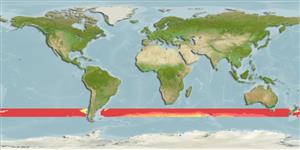Environment: milieu / climate zone / depth range / distribution range
Ecology
Marine; bathypelagic; oceanodromous (Ref. 51243). Deep-water; 40°S - 50°S
Generally ranges between about 40°S and 50°S. Its distribution in the south-western Atlantic can be correlated with 34.6 ppt isohaline at 200 m. In the Southern Ocean, known from 45°10'S, 69°12'E.
Size / Weight / Age
Maturity: Lm ? range ? - ? cm
Max length : 13.0 cm SL male/unsexed; (Ref. 5182)
Oceanic and mesopelagic (Ref. 4066). Juveniles found in the upper 100 m (night), adults mainly below about 200 m (night).
Life cycle and mating behavior
Maturities | Reproduction | Spawnings | Egg(s) | Fecundities | Larvae
Hulley, P.A., 1990. Myctophidae. p. 146-178. In O. Gon and P.C. Heemstra (eds.) Fishes of the Southern Ocean. J.L.B. Smith Institute of Ichthyology, Grahamstown, South Africa. (Ref. 5182)
IUCN Red List Status (Ref. 130435)
Threat to humans
Harmless
Human uses
Tools
Special reports
Download XML
Internet sources
Estimates based on models
Preferred temperature (Ref.
123201): 1.8 - 2.9, mean 2.3 °C (based on 293 cells).
Phylogenetic diversity index (Ref.
82804): PD
50 = 1.0000 [Uniqueness, from 0.5 = low to 2.0 = high].
Bayesian length-weight: a=0.00437 (0.00199 - 0.00957), b=3.16 (2.96 - 3.36), in cm total length, based on LWR estimates for this (Sub)family-body shape (Ref.
93245).
Trophic level (Ref.
69278): 3.2 ±0.4 se; based on size and trophs of closest relatives
Resilience (Ref.
120179): Medium, minimum population doubling time 1.4 - 4.4 years (Preliminary K or Fecundity.).
Fishing Vulnerability (Ref.
59153): Low vulnerability (10 of 100).
